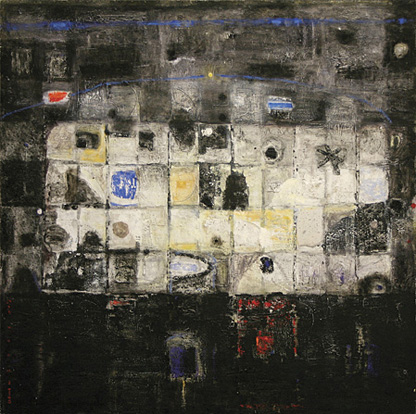
Nizar Sabour was born in Lattakia, Syria in 1958. He graduated from the Faculty of Fine Arts, Damascus University in 1981 and obtained his PhD from Moscow University in The Philosophy of Art in 1990.
Sabour’s work tends to have religious undertones, focusing on the artist’s fascination with religious imagery and icons, whether Christian, Islamic or pagan. His images tend to appear worn and archaic, utilizing ‘traditional’ elements such triptychs, carved wood, flattened perspective, verticality and gold leaf. However he treats these elements in a very non-traditional manner and purposefully and successfully counterbalances any religiosity by employing colours and a technique that is more reminiscent of Dada collages than the precision of religious iconography. His later work is even more diverse, employing similar techniques but moving away from any particular theme. Generally larger scale and even at times covering entire walls, Sabour’s more recent work also features more primordial objects and Islamic architectural motifs, as well as ash as a medium. Nizar’s employment of ash, a material often associated with death and decay, suggests his desire to render work inherent of a sense of fragility, agedness and spirituality.
Nizar Sabour received an award of recognition at the 2nd Sharjah International Art Biennal in 1995. In 2004, he was awarded the first prize in painting at the International Art Symposium in Dubai. His work can be seen at the Museum of Eastern Culture (Moscow, Russia), Gallery Oscar (Washington D.C., USA), The Ministry of Culture (Damascus, Syria), Bahrain National Museum, (Manama, Bahrain) and The Jordanian Royal Museum (Amman, Jordan).

















